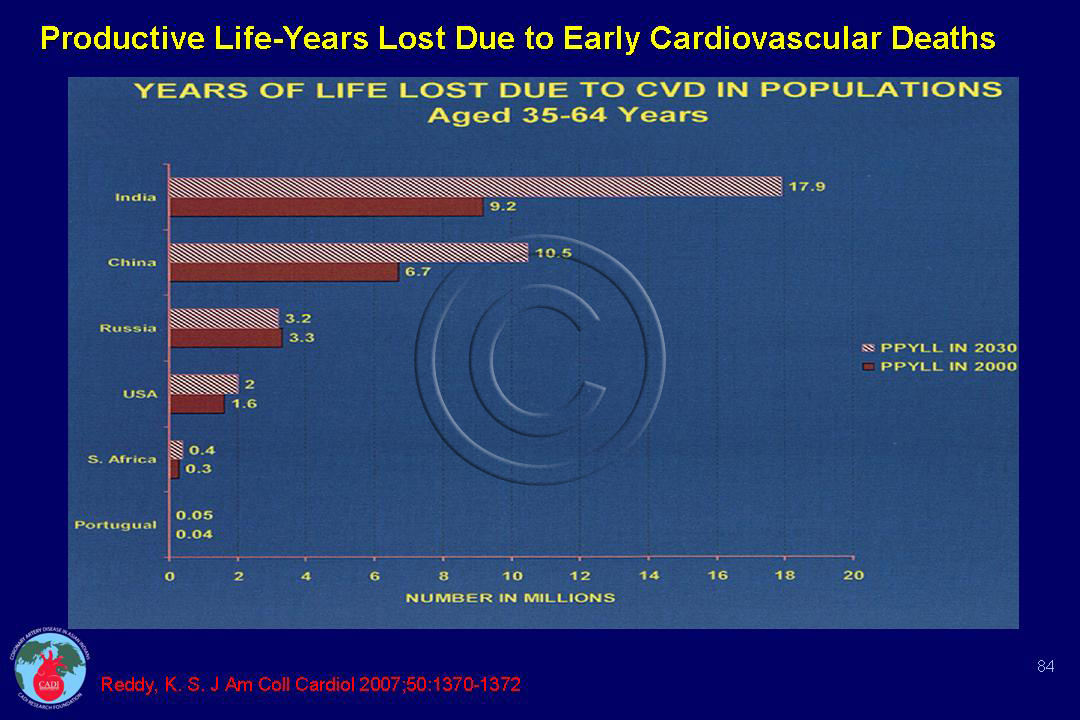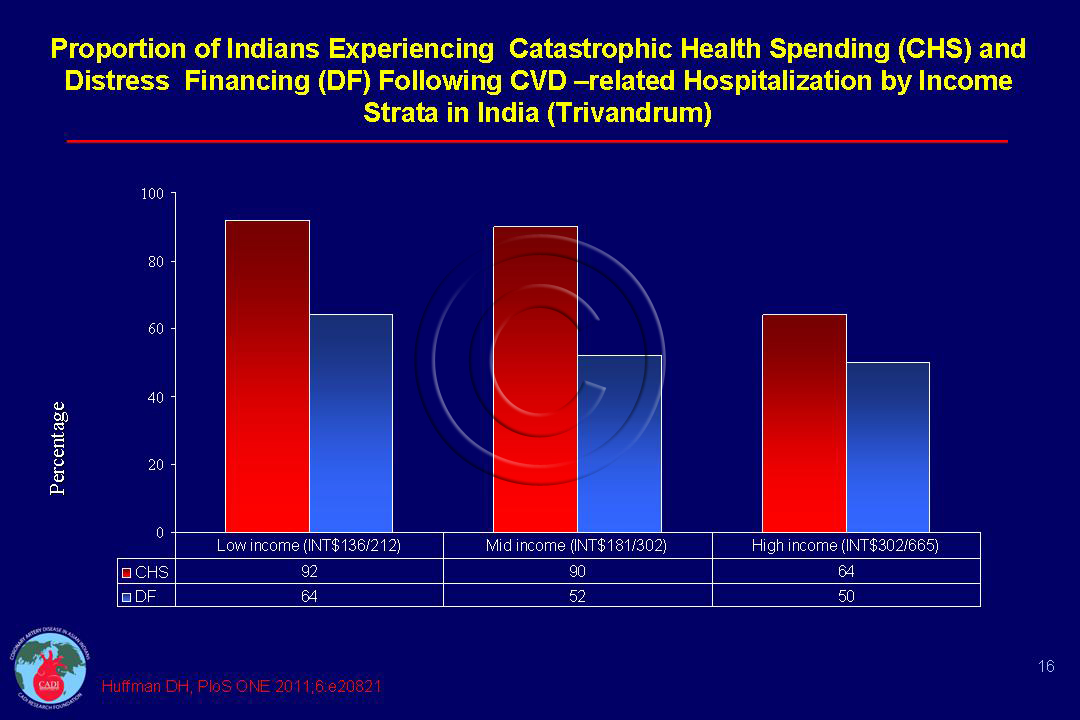Economic Burden of Heart Disease in India
- Malignant atherosclerosis at a young age along with high case-fatality rate (death following a heart attack) results in greater morbidity and mortality from coronary artery disease (CAD) in India. Mortality rate following a heart attack among Indians is double that of Chinese.1 This results in an excessive loss of productive years of life, posing a heavy economic burden on the nation.1
- Deaths due to CVD, in the working age group (25 to 64 years) resulted in 9.2 million potentially productive years of life being lost in 2000 and is expected to increase to a loss of 17.9 million years by 2030.2, 3 (It was assumed that each individual who died of CVD, did so at age 50 and not able to continue to work and retire at age 60, thereby losing an average of 10 years of productive life years). This figure is higher than losses predicted for China, Russia, US, South Africa, and Portugal combined (16.2 million) as shown in Figure 084.4
- The World Bank estimates DALYs (disability adjusted life years) lost due to heart diseases of 18.2 million in 2010 in India and is projected to be more than double in the next 20 years.5
- The economic impact was estimated to be $9 billion in national income from premature deaths due to heart disease, stroke, and diabetes in 2005 alone, with cumulative projected estimates of $237 billion by 2015.5, 6
- India spends less than 1% for health care compared to 17% in the US. Since the government spends only 17-18% of this, the out-of-pocket health expenses incurred by households is as high as 80% or more.4, 5, 7 Many diabetic patients spend 25% of the household income for diabetes care alone.8
- Heart disease is a silent disease with 75% of the patients being unaware of the presence of the disease. Therefore, only 25% would receive any kind of treatment (statins, aspirin, beta blockers, hospitalization, thrombolytic therapy, angioplasty, stent, and bypass).
- According to Dr. Rajeev Gupta, the direct economic burden of heart disease in India could be 200 billion rupees ($ 4.5 billion). This would increase to 800 billion rupees ($ 18 billion) if 100% of the CAD patients were aware and received necessary treatment. Indirect costs would make the numbers even higher.
- The economic burden of CVD varies among states with Kerala amounting to as much as 20% of its state domestic product.3
- Most of this expenditure should be considered as futile, since more than 80% of the heart attacks can be prevented by appropriate management and prevention strategies.5
- The WHO (World Health Organization) has estimated that a 2% annual reduction in national-level chronic disease death rates in India would result in an economic gain of USD 15 billion for the country over the next 10 years.4
- Modeling studies have shown that the per capita real GDP in India would grow by an additional 87% from the year 2000 per capita GDP if the annual CVD mortality declines by 1%, whereas a 3% annual decline in CVD mortality would increase per capita income by 218% by the year 2030.4
- India has been known as a land of disparity. According to a new report from the Asian Development Bank (ADB) published by the Times Nation (August 23, 2010), 75% (825 millions) of Indians are poor with an earning less than Rs.1035 per month; 20% or 224 million are lower middle class earning Rs1035-2070; 4% (45 million) are middle middle class earning Rs 2070-5177 per month. Only 0.45% (5 million) are upper middle class earning Rs 5177 to 10,354 per month; less than one in one-thousand (0.0009%) Indians (1 million) are rich earning more than Rs 10,354 per month; Thus a total of 274 million are middle class with an annual income ranging from $275 to $2760 per year and one million earning more than $2760 per year (calculation based on the current exchange rate of Rs 45 per $1, but the purchasing parity is Rs 17.3).
- More than 80% of the population pays out of pocket for healthcare expenditure. As a result 30 million are pushed into poverty every year.9, 10
- India had the highest 15-month out-of-pocket CVD expenditures where the median income was INT (International Dollars) $259/month and only 16% of the respondents had insurance coverage. The combined inpatient and outpatient services CVD expenditure ranged from INT $773 in low-income to $1593 in middle income and $2917 in high income Indians, whereas the median individual monthly income was $136, $181 and $302 respectively.11 The household median income was INT $212, INT $302 and INT $665 respectively. Thus us the average out-of-pocket CVD expenditure was the equivalent of >6 month salary for all income groups.11
- By comparison, in-hospital out-of-pocket expenditures for CVD in the United States were estimated to be INT $1,229 in 2006.11
- Catastrophic health spending (annual out-of-pocket health expenditures >40% of total, non-food household expenditures) was 85-90% in low and middle income and 65% among high income Indians (Trivandrum). Distress financing (borrowing money from lenders at exorbitant interest rates or selling assets) was present in 50% -65% of subjects in India (Figure 016).11
Sources
1. Prabhakaran D, Yusuf S, Mehta S, et al. Two-year outcomes in patients admitted with non-ST elevation acute coronary syndrome: results of the OASIS registry 1 and 2. Indian heart journal. May-Jun 2005;57(3):217-225.
2. Reddy KS, Satija A. The Framingham Heart Study: impact on the prevention and control of cardiovascular diseases in India. Prog Cardiovasc Dis. Jul-Aug 2010;53(1):21-27.
3. Mahal A, Karan A, Engelgau MM. The Economic Implications of Non-Communicable Disease for India: avaible at WWW.World Bank/documents and reports. Accessed November 1, 2010;2010.
4. Vamadevan AS, Shah BR, Califf RM, Prabhakaran D. Cardiovascular research in India: a perspective. Am Heart J. Mar 2011;161(3):431-438.
5. Gupta R. Coronary heart disease in India: Absolute numbers and economic burden. 2004 April 6.
6. World Health Organization. Prevention of cardiovascular disease: A vital investment. World Health Organization, Geneva Switzerland2007.
7. Prabhakaran D, Yusuf S. Cardiovascular disease in India: lessons learnt & challenges ahead. Indian J Med Res. Nov 2010;132(5):529-530.
8. Ramachandran A, Ramachandran S, Snehalatha C, et al. Increasing expenditure on health care incurred by diabetic subjects in a developing country: a study from India. Diabetes Care. Feb 2007;30(2):252-256.
9. Gupta R, Guptha S, Joshi R, Xavier D. Translating evidence into policy for cardiovascular disease control in India. Health Res Policy Syst. 2011;9:8.
10. van Doorslaer E, O’Donnell O, Rannan-Eliya RP, et al. Effect of payments for health care on poverty estimates in 11 countries in Asia: an analysis of household survey data. Lancet. Oct 14 2006;368(9544):1357-1364.
11. Huffman M D, Rao KD, Pichon-Riviere A, et al. A cross-sectional study of the microeconomic impact of cardiovascular disease hospitalization in four low- and middle-income countries. PLoS ONE. 2011;6(6):e20821.



